Insight A System - 3rd Planet (Insight A-III)




Pictures of the day - December 16, 2018
Insight A System - 3rd Planet (Insight A-III)
Insight A-III is the third planet orbiting Insight A. It is a hot Ice-giant orbiting it’s sun at an average distance of 0.12 AU. The planet’s atmosphere has a temperature of 960 F and it’s atmosphere lacks any type of define cloud decks. This is a helium ice giant, meaning that it has lost all of it’s hydrogen and the atmosphere is dominated by helium instead. As a result, the planet has a monochromatic color.
Insight A-III has a mass of 13.22 Earths, and a diameter of 4.03 times that of Earth. The planet is tidally locked to it’s sun and orbits the sun once every 14.76 Earth days.
High Resolution Pictures
Insight A-III
Lunar View
Asteroid Moon
Blinding Sun and Inner Planets
More Posts from Sharkspaceengine and Others

For scientists watching the Red Planet from our orbiters, the past month has been a windfall. “Global” dust storms, where a runaway series of storms create a dust cloud so large they envelop the planet, only appear every six to eight years (that’s 3-4 Mars years). Scientists still don’t understand why or how exactly these storms form and evolve.
Read the full story HERE.
Make sure to follow us on Tumblr for your regular dose of space: http://nasa.tumblr.com.
Lonely Moon

Picture of the Day - October 19, 2018
Small moon passing in front of a large Super-Earth type planet.
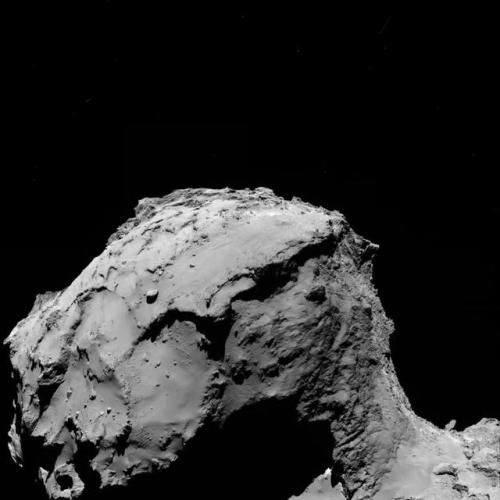
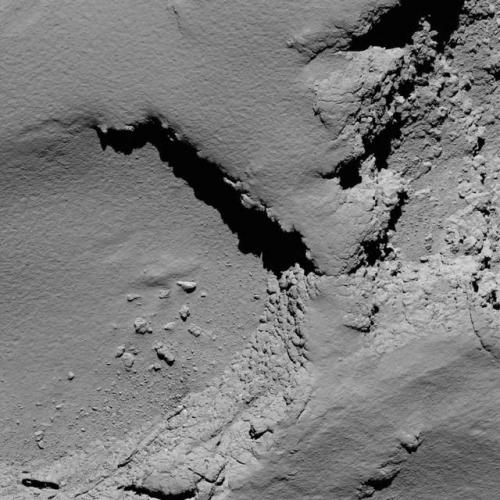
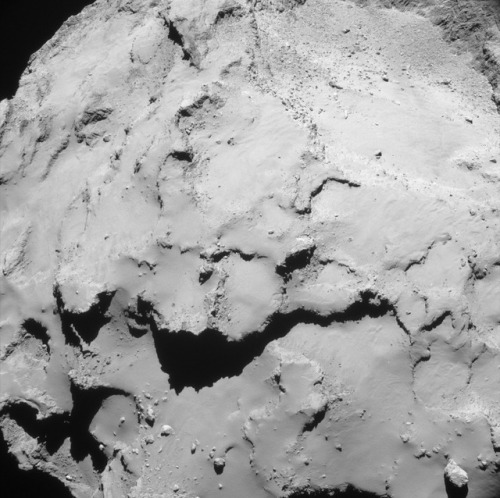
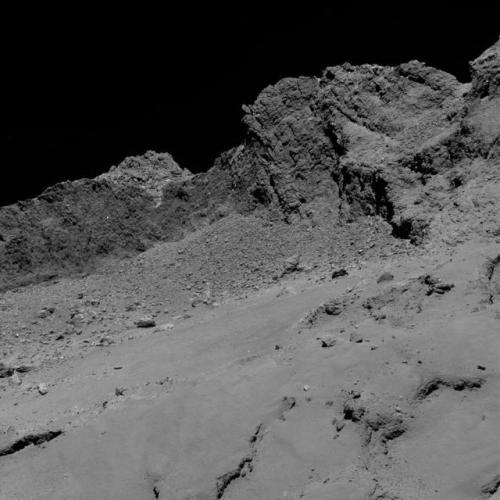
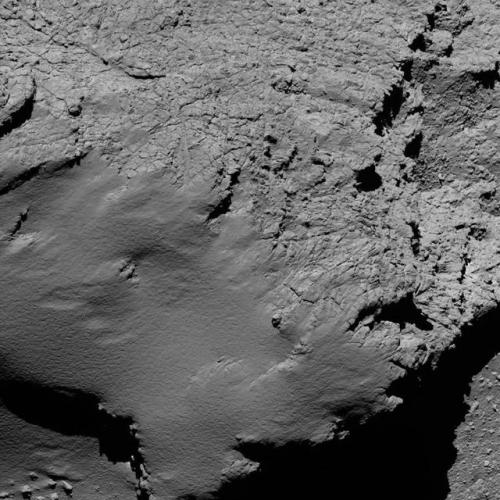
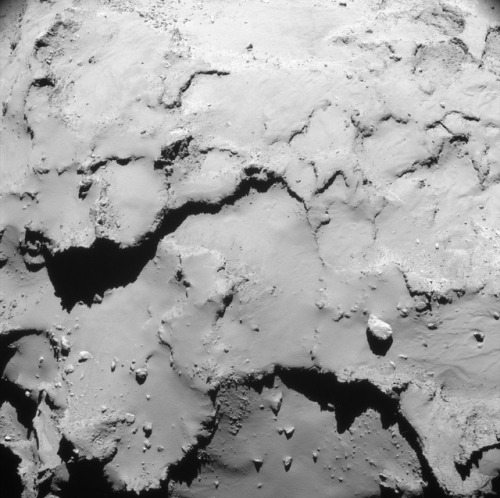
September 30, 2016: Views of Comet 67P/Churyumov-Gerasimenko captured by the Rosetta probe during the spacecraft’s final descent.
(ESA)






O’Sirus System - Post 4 (Rings)
Two planets in the O’Sirus System have rings, the 7th and 10th planets respectively.
The 7th planet is an ice-world with a thick icy crust floating on a sub-surface ocean. It is roughly 0.30 Earth-masses, has a radius 75% that of Earth and orbits 1.32 AU from the sun. The surface has a carbon dioxide atmosphere of approximately the same pressure as the atmosphere of Mars and surface temperatures of 133 K or -224 °F.
The 10th world is small ice giant 10.5 times more massive than Earth, has a radius 2.8 times larger than Earth and orbits at a distance of 6.02 AU. This world also has a pronounced ring system.
High Resolution Pics
Picture 1 - The 7th Planet
Picture 2 - Ring Closeup
Picture 3 - Another Closeup
Picture 4 - The 10th Planet
Picture 5 - Closeup
Picture 6- Ring Transit










MESSENGER Spacecraft
MESSENGER (whose backronym is Mercury Surface, Space Environment, Geochemistry, and Ranging, and which is a reference to the Roman mythological messenger, Mercury) was a NASA robotic spacecraft that orbited the planet Mercury between 2011 and 2015. The spacecraft was launched aboard a Delta II rocket in August 2004 to study Mercury’s chemical composition, geology, and magnetic field.

The instruments carried by MESSENGER were used on a complex series of flybys – the spacecraft flew by Earth once, Venus twice, and Mercury itself three times, allowing it to decelerate relative to Mercury using minimal fuel. During its first flyby of Mercury in January 2008, MESSENGER became the second mission after Mariner 10’s 1975 flyby to reach Mercury.
MESSENGER entered orbit around Mercury on March 18, 2011, becoming the first spacecraft to do so. It successfully completed its primary mission in 2012. Following two mission extensions, the MESSENGER spacecraft used the last of its maneuvering propellant and deorbited as planned, impacting the surface of Mercury on April 30, 2015
Source
Image Credit: NASA/Johns Hopkins University Applied Physics Laboratory/Carnegie Institution of Washington
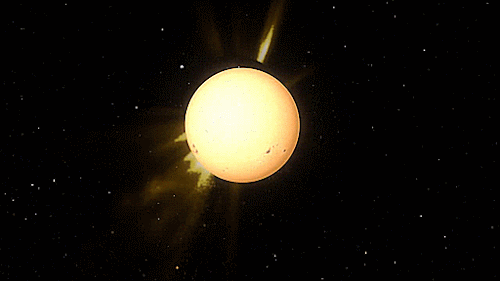


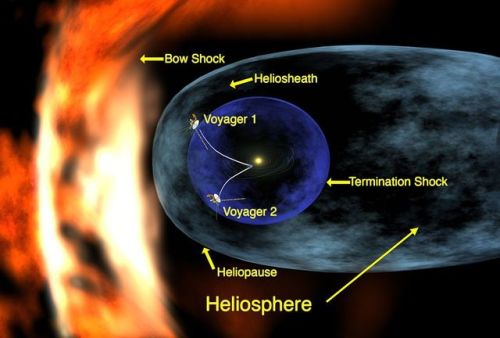
The heliosphere is the bubble-like region of space dominated by the Sun, which extends far beyond the orbit of Pluto. Plasma “blown” out from the Sun, known as the solar wind, creates and maintains this bubble against the outside pressure of the interstellar medium, the hydrogen and helium gas that permeates the Milky Way Galaxy. The solar wind flows outward from the Sun until encountering the termination shock, where motion slows abruptly. The Voyager spacecraft have explored the outer reaches of the heliosphere, passing through the shock and entering the heliosheath, a transitional region which is in turn bounded by the outermost edge of the heliosphere, called the heliopause. The shape of the heliosphere is controlled by the interstellar medium through which it is traveling, as well as the Sun and is not perfectly spherical. The limited data available and unexplored nature of these structures have resulted in many theories. The word “heliosphere” is said to have been coined by Alexander J. Dessler, who is credited with first use of the word in the scientific literature.
On September 12, 2013, NASA announced that Voyager 1 left the heliopause on August 25, 2012, when it measured a sudden increase in plasma density of about forty times. Because the heliopause marks one boundary between the Sun’s solar wind and the rest of the galaxy, a spacecraft such as Voyager 1 which has departed the heliosphere, can be said to have reached interstellar space. source

Horns by Michal Kváč https://ift.tt/2zvtNZ1
Hey Tumblr!
I have started a new blog to share the joys of fishing and kayaking! This post is all about the best cheap kayaks for under 200 dollars. I hope some of you who are interested can find more about kayaking and fishing! Either way, it’s worth a read if you have a minute. It might just save you a few hundred dollars down the road.
Read my blog at Get Fishing Equipment




My first posts will be from systems located within the Triangulum Galaxy. The above 3 images were taken from Space Engine of the galaxy. The background galaxy in the images is Andromeda.
For those of you that are not familiar with the Triangulum Galaxy, it is the third largest member of the local group, sometimes considered a satellite galaxy of Andromeda. The galaxy is also known as M33, NGC 598 or the Pinwheel Galaxy. Approximately 40 billion stars reside within this spiral galaxy. It is believed that the galaxy lacks a central supermassive black hole and central halo.
Wikipedia link below.
Triangulum Galaxy





Pictures of the day - December 5, 2018
I apologize for my lack pictures yesterday.
Insight B System - Fourth Planet - Insight B-V
The fifth planet orbiting Insight B is a terrestrial-like planet roughly one quarter the mass of earth (0.27 Earth Masses) and 80% of Earth’s radius (5,093.84 km). It is predominately rocky world with a significant water content in its mantle, surrounded by a thin Carbon Dioxide atmosphere.
The surface is cold with an average temperature of -159 F, and an atmospheric pressure of 0.11 atmospheres. A single small spherical satellite orbits the planet. One day lasts approximately 23 hours 38 mins. Insight B-V orbits its sun at an average distance of 0.97 AU, completing an orbit once every 1.163 Earth Years. The planet is notable for having a retrograde rotation, orbiting almost on its side with an axial tilt of 104°. Considering the planet orbits between two gas giants, the extreme tilt is to be expected.
High Resolution Pictures
Insight B-V
Small Moon
Closeup
Day-time sky
Sunset
Insight A System (Inner 5 Planets)
First post of the Insight A system. Insight A is the larger or primary of Insight’s 2 stars. The Insight System is a wide-spaced binary system consisting of a type G1V and type K5V star that orbit one another at an average distance of 192.3 AU once every 2,432 years. Insight A is 1.6 times the luminosity of our sun, and Insight B just 1/6th that of our sun.
Below are the first five worlds orbiting Insight A.
Insight A-I (0.56 Earth Masses - Rocky, 0.04 AU)

Insight A-II (2.66 Earth Masses, Rocky Super Earth, 0.07 AU)

Insight A-III (13.22 Earth Mass, Ice-Giant, 0.12 AU)

Insight A-IV (41.38 Earth Masses, Ice Giant, 0.36 AU)

Insight A-V (0.14 Earth Masses, Rocky with Liquid Water, 0.69 AU)

-
 zoccket reblogged this · 3 years ago
zoccket reblogged this · 3 years ago -
 zoccket liked this · 3 years ago
zoccket liked this · 3 years ago -
 harmonicgamingangel22blog liked this · 6 years ago
harmonicgamingangel22blog liked this · 6 years ago -
 sharkspaceengine reblogged this · 6 years ago
sharkspaceengine reblogged this · 6 years ago
My Space Engine Adventures, also any space related topic or news. www.spaceengine.org to download space engine. The game is free by the way. Please feel free to ask me anything, provide suggestions on systems to visit or post any space related topic.Check out my other blog https://bunsandsharks.tumblr.com for rabbit and shark blog.
294 posts